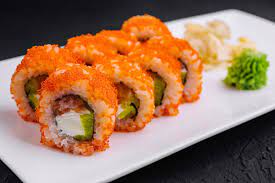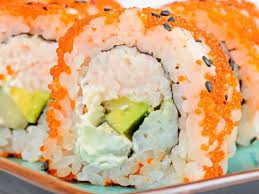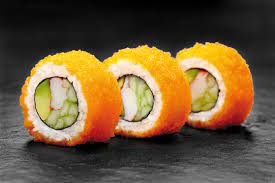Masago or smelt eggs are edible capelin eggs. Rich in proteins, nutrients and vitamin B12. However, people with high blood pressure or seafood allergies should exercise caution when considering this ingredient. Fish roe is the fully mature egg of many types of fish, including sturgeon, salmon, and herring.
Masago are the eggs of capelin, a small fish found in the cold waters of the North Atlantic, North Pacific, and Arctic. Masago is a popular ingredient in Asian cuisine and is highly valued for its unique flavor, making it a specialty product.
In this article, we will talk about the benefits of masago, masago vs tobiko and uses of Masago.

What is Masago?
Stintrogen – commonly known as masago – is the edible egg of the capelin (Malotus villosus), a member of the smelt family.
They are considered forage fish, meaning they are an important food source for larger predators such as cod, sea birds, seals and whales. This small silver-green fish looks like a sardine.
Although capelin meat is edible, it is most needed by fishermen to make other products such as masago.
About 80% of the harvested capelin is used to produce fish meal and fish oil products, and the remaining 20% is used to produce masago.
Female capelins begin laying eggs at about 2 to 4 years of age and continue to lay eggs until they die.
Masago is collected from female capelin fish, which are full of eggs before they spawn. Commonly used as an ingredient in sushi rolls, it is pale yellow in color, but is often dyed in bright shades of orange, red, and green to add visual interest to dishes.
It has a mild flavor and is sometimes mixed with wasabi, squid ink, ginger, etc.
Masago vs Tobiko
Masago is often confused with tobiko, which is the egg or eggs of flying fish. Although tobiko and masago are similar, there are important differences. Masago is smaller and cheaper than tobiko, so it is popular as a substitute for tobiko in sushi rolls.
In contrast to tobiko’s natural bright red color, masago is a pale yellow color and is often dyed to add visual interest.
Masago tastes similar to tobiko but is not as crisp. Overall, tobiko and masago are very similar, but tobiko is considered a higher-quality sushi topping in terms of price and quality.
Low in calories but rich in nutrients
Like other types of fish roe, masago is low in calories but rich in many important nutrients. Contains only 1 ounce (28 grams) of fish roe.
- Calories: 40
- Fat: 2 grams
- Protein: 6 grams
- Carbs: less than 1 gram
- Vitamin C: 7% of the Daily Value (DV)
- Vitamin E: 10% of the DV
- Riboflavin (B2): 12% of the DV
- Vitamin B12: 47% of the DV
- Folate (B9): 6% of the DV
- Phosphorus: 11% of the DV
- Selenium: 16% of the DV
Fish eggs are particularly rich in vitamin B12. Vitamin B12 is a water-soluble vitamin that cannot be produced by the body and must be obtained from food or supplements.
Vitamin B12 is essential for many functions such as red blood cell development, energy production, neurotransmission and DNA synthesis.
The eggs of fish like masago are low in carbohydrates but rich in protein and healthy fats, including omega-3 fatty acids.
These polyunsaturated fats help control inflammation and are essential for the proper function of the immune system, heart, hormones and lungs.
In addition, fish eggs are rich in amino acids, which are the building blocks of proteins, especially lysine, valine, histidine, leucine, isoleucine, and phenylalanine. Leucine and lysine are essential for protein synthesis and muscle repair.

Detailed on Tobiko vs Masago
Tobiko and Masago are both types of fish that are commonly used in Japanese cuisine, especially sushi. Although there are similarities between the two, there are some differences.
Tobiko:
Origin: Tobiko comes from flying fish, or more precisely, flying fish eggs. It is characterized by its chewiness and slightly larger grains than masago.
Colors: Tobiko is known for bright colors such as orange, red, green, and black. Color is often achieved through natural or artificial means to add visual appeal to sushi dishes.
Taste: Tobiko has a mild salty taste and a slight sweetness. Each egg is firm and has a unique texture that bursts when you bite into it. Use in Sushi: Tobiko is commonly used as a topping for a variety of sushi dishes, including nigiri, sashimi, and maki. It is valued not only for its taste but also for its beautiful appearance.
Masago:
Origin: Masago is usually made from shishamo, a small smelt fish. The grains are smaller than Tobiko’s.
Color: Masago is generally orange, but other colors are available. It is not as active as the tobiko and looks more delicate.
Taste: Compared to Tobiko, Masago has a milder taste and a slightly softer texture. The eggs are smaller, so you can enjoy a different texture.
Use in Sushi: Like Tobiko, Masago is often used as an ingredient in sushi rolls, nigiri, and gunkan sushi. It gives dishes a delicate flavor and delicate texture. Personal preference often plays an important role when it comes to choosing between tobiko and masago. Some people prefer the large, crunchy texture of tobiko, while others prefer the small, soft grains of masago. Additionally, the selection may also be influenced by the desired color and visual expression of the sushi plate.
Health Benefits Possible
Like other types of seafood, masago is highly nutritious and offers a variety of health benefits.
Contains plenty of high-quality protein
Masago is small but rich in protein. Each 28-gram serving provides 6 grams of high-quality protein. This is approximately equivalent to one large egg (50 grams).
Compared to the other two macronutrients, carbohydrates and fat, protein is the most satiating and helps satisfy hunger.
Adding protein-rich foods like masago to your diet can help keep you satiated, prevent overeating, and promote weight management.
Fish eggs are a complete protein and contain all nine essential amino acids required by the body.
Natural Sources of Selenium and Vitamin B12
Masago is an excellent source of selenium, a mineral that acts as a powerful antioxidant in the body.
Selenium, which is abundant in seafood, reduces oxidative stress and plays an important role in the thyroid and immune system.
Studies have shown that increased levels of selenium in the blood strengthen the immune response and prevent mental decline, but the results are inconclusive.
Masago is also rich in vitamin B12, which is essential for nerve health, energy production and other vital body functions.
Rich in Omega-3 Fatty Acids
Omega-3 fats are polyunsaturated fats that have many powerful health benefits.
These special fats control inflammation, regulate blood clotting and are an important part of cell membranes.
Research shows that consuming more foods rich in omega-3 fats reduces the risk of cardiovascular disease, such as heart failure and coronary artery disease.
Fish products like fish and masago are one of the best nutritional sources of omega-3 fats.
Low Mercury Content
Because capelin is a small bait fish, it has much lower levels of mercury than larger fish like mackerel and marlin.
Additionally, studies have shown that fish eggs have the lowest concentrations of mercury compared to other parts of the fish, such as organs and muscle tissue.
For this reason, consuming fish like masago is also safe for people who want to reduce their exposure to mercury.
Potential Loss
While masago has some health benefits, it also has potential disadvantages.
Ecological concerns about capelin fisheries
Although masago may be a better choice than other types of seafood, buyers should be aware of some concerns about by-catch of the endangered and overfished species associated with capelin fishing methods.
Environmental groups raise concerns about uncertainty over capelin populations and some fishing methods
Because female capelin fish carrying eggs are often targeted to meet the demand for masago, some environmental groups say this practice could have a negative impact on the species’ population over time. I am worried.
High Sodium Content
Like most other fish eggs, masago is high in sodium.
Additionally, masago is often mixed with salty ingredients such as soy sauce or salt to enhance the flavor, increasing the sodium content of the final product.
Consuming too much salt can be harmful to your health and may increase blood pressure in people who are salt-sensitive.
Risk of an Allergic Reaction
Masago is a seafood product, so people with seafood allergies should avoid it. Fish eggs contain vitellogenin, an egg yolk protein that is considered a potential allergen.
Additionally, fish eggs can cause allergic reactions even in people who are not allergic to seafood. These include skin rashes, narrowing of the airways and low blood pressure.
In Japan, fish eggs are the sixth most common food allergen.
Can be mixed with other ingredients
People who consume masago will want to pay attention to the ingredients that are often mixed with it, such as B. High fructose corn syrup and Monosodium Glutamate (MSG).
Regular consumption of high fructose corn syrup is linked to metabolic disorders, insulin resistance and inflammation
MSG is a common food additive used to improve the taste of products such as masago.
There is little qualitative evidence that MSG causes side effects. However, some people experience headaches, weakness, and skin redness after consuming MSG.
Masago is a unique ingredient that can be used for a variety of purposes.
Its semi-crisp texture and salty flavor make it perfect for Asian-inspired dishes and appetizers. You can buy it in a variety of flavors, including ginger, wasabi, and squid ink, from many seafood retailers.
Here’s how to include muscovado in your diet.
(a) Top your homemade sushi rolls with a few spoonfuls of masago.
(b) Fill a plate with masago, cheese and fruit to make a delicious appetizer.
(c) Add masago to your poke bowl for a unique topping. Add masago to Asian noodle dishes.
(d) Serve the fish with masago to add flavor to the recipe.
(e) Add flavor to sushi rolls by mixing masago with wasabi or spicy mayonnaise.
(f) Masago contains a lot of salt, so you can get a strong taste even with small amounts. Masago is used to add spice to rice.
Masago is most commonly used in Asian cooking, but it can be incorporated into many dishes where it pairs well with savory dishes. Masago or smelt eggs are edible capelin eggs.
It is rich in nutrients like protein, omega-3 fatty acids, selenium and vitamin B12.
Be wary of egg products that contain added ingredients such as salt, monosodium glutamate and high fructose corn syrup. Limit masago if you have high blood pressure and avoid it altogether if you are allergic to seafood.
However, if you can tolerate seafood and are looking for an interesting ingredient to add extra flavor to your dishes, try masago.
Read Also: Can 12 Year Old Drink Sting Engery Drink?
Health benefits of masago
Masago is the egg of Shishamo (small smelt). It is a common ingredient in Japanese cuisine, often used as a topping for sushi rolls and other dishes. Masago is a delicious addition to a variety of dishes, but it’s important to note that, like many other foods, it must be consumed in moderation. Potential health benefits associated with masago include:
Rich in Nutrients: Masago is an excellent source of several essential nutrients, including protein, omega-3 fatty acids, and various vitamins and minerals. These nutrients are important for overall health and well-being.
Protein Content: Masago is a protein-rich food that is essential for the growth, repair, and maintenance of the body. Protein is especially important for muscle building and the function of various enzymes and hormones.
Omega-3 fatty acids: Masago contains omega-3 fatty acids, which are known for their heart-healthy benefits. These fatty acids reduce inflammation, lower blood pressure, and support cardiovascular health.
Vitamins and Minerals: Masago contains vitamins such as vitamin B12, which is important for nerve function and red blood cell production. It also replenishes minerals such as selenium, which has antioxidant properties. Low Calorie: Masago is relatively low in calories, making it a good addition to meals for people who want to keep their calorie intake in check while still enjoying flavorful toppings.
Improved taste and texture: Besides its nutritional value, masago is also valued for its taste and texture. It adds flavor and a pleasant texture to a variety of dishes, enhancing the overall dining experience.
It is important to consume masago as part of a balanced and varied diet. However, masago can cause allergic reactions, so people who are allergic to seafood should avoid it. As with any food, moderation is important and we recommend consulting your doctor or dietitian for personalized nutritional advice.

Masago Sushi
Masago sushi is a type of sushi that uses masago as one of the main ingredients. Masago refers to small orange fish roe derived from capelin and is often used as a side dish or topping in Japanese cuisine. When it comes to sushi, masago adds flavor, color, and texture.
Here are some common types of sushi including masago.
Masago nigiri: A type of nigiri sushi consisting of a small mound of vinegared rice with a layer of masago on top.
Masago Gunkan: Gunkan sushi is a small oval of hand-pressed rice wrapped in seaweed in the shape of a “gunkan”. Masago is often used as an ingredient in gunkan sushi.
Masago Roll: Masago is often used as a topping for a variety of sushi rolls, such as California rolls and spicy tuna rolls. It gives the rolls a crunchy texture and flavor.
Masago Sashimi: Sashimi is traditionally thinly sliced raw fish, but masago can be used as a topping or garnish to add color and flavor.
Since masago is a product made from fish eggs, it is important to be aware of seafood allergies when eating masago sushi. Also, specific ingredients and cooking methods may vary depending on the sushi chef or restaurant.
Masago has a slightly sweet and umami flavor, and is popular among people who enjoy the unique flavor and texture it adds to sushi toppings. As with all sushi, it is best enjoyed in moderation as part of a balanced diet.

Pingback: Surfside Drink: A Refreshing Journey - Stingdrink.com
Pingback: Malibu Strings: Sensuality and Style 2024